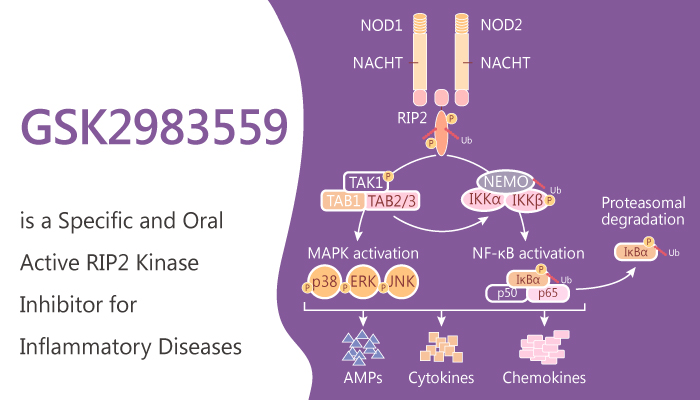The innate immune system is a key driver of our immune response from birth. It provides an immediate response to foreign invaders. It comprises pattern recognition receptors (PRRs). Toll-like receptors (TLR) and C-type lectin receptors (CLR) are transmembrane receptors, reaching either into the extracellular space or across the endosomal membrane, while Nod-like receptors (NLR) and Rig-I-like receptors (RLR) are cytoplasmic. Meanwhile, the NLR nucleotide oligomerization domain 2 (NOD2) plays an important role in the homeostasis of the innate immune system. Strong genetic evidence has directly linked NOD2 to a rare autoinflammatory disease through the overactivation of the pathway. Besides, it is in a multitude of inflammatory diseases. Receptor-interacting-protein kinase 2 (RIP2) is also a key signaling partner of NOD2. Activation of RIP2 kinase through ATP driven autophosphorylation drives downstream signal transduction. In this study, GSK2983559 is a potent, specific and oral bioavailable RIP2 kinase inhibitor.

RIP2 contains an N-terminal domain with homology to Ser/Thr kinases and C-terminal caspase activation and recruitment domain (CARD), a homophilic interaction motif. It mediates the recruitment of caspase death proteases. Overexpression of RIP2 signaled both NF-kappaB activation and cell death. Moreover, mutational analysis reveals the pro-apoptotic function of RIP2 to be restricted to its C-terminal CARD domain, whereas the intact molecule was necessary for NF-kappaB activation. RIP2 interacted with other members of the TNFR-1 signaling complex, including the inhibitor of apoptosis protein cIAP1 and with members of the TNFR-associated factor (TRAF) family, specifically TRAF1, TRAF5, and TRAF6. These TRAF interactions mediate the recruitment of RIP2 to receptor signaling complexes. GSK2983559 has excellent activity in blocking many proinflammatory cytokine responses in vivo and in human inflammatory bowel disease explant samples.
In summary, GSK2983559 is a first-in-class RIP2 kinase-specific clinical candidate for the treatment of inflammatory diseases.
Reference:
Haile PA, et al. J Med Chem. 2019 Jul 25;62(14):6482-6494.